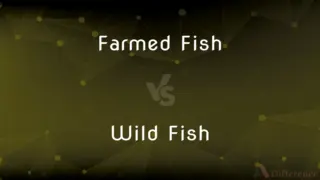Antelope vs. Chamois — What's the Difference?
By Maham Liaqat & Fiza Rafique — Updated on May 2, 2024
Antelope refers to various even-toed ungulate species within the family Bovidae, noted for their speed and agility, while chamois is a goat-antelope native to European mountains, recognized for its climbing ability.

Difference Between Antelope and Chamois
Table of Contents
ADVERTISEMENT
Key Differences
Antelope encompasses a wide range of species found primarily in Africa and parts of Asia, adapted to diverse habitats from savannas to forests. In contrast, chamois are specifically adapted to rugged mountainous terrains in Europe, thriving in high altitudes where they skillfully navigate steep slopes.
Most antelopes are characterized by their slender bodies and long legs, which facilitate high-speed pursuits necessary in open plains to evade predators. On the other hand, chamois possess a robust build with shorter, sturdy legs suited for stability on rocky surfaces and abrupt changes in elevation.
Antelopes generally have a diet that consists predominantly of grasses, reflecting their evolution in grass-rich ecosystems. Whereas, chamois have a more varied diet that includes grasses, herbs, and leaves, adapted to the less abundant food sources in alpine environments.
The social structures of antelopes vary widely among species; some form large herds, while others are solitary or live in small family groups. Conversely, chamois tend to form smaller, more tight-knit groups, which is advantageous for detecting predators in mountainous terrain.
In terms of conservation status, while some antelope species are abundant and of least concern, others are critically endangered due to habitat loss and poaching. Chamois, meanwhile, maintain a stable population but are monitored to prevent potential declines due to hunting and habitat disturbance.
ADVERTISEMENT
Comparison Chart
Habitat
Mostly Africa and parts of Asia, varied from grasslands to forests
European mountains, rugged terrains
Body Shape
Slender with long legs
Robust with shorter, sturdy legs
Diet
Mainly grasses
Grasses, herbs, leaves
Social Structure
Varies, from large herds to solitary
Small groups
Conservation Status
Ranges from least concern to critically endangered
Generally stable but monitored
Compare with Definitions
Antelope
Any of various species within the Bovidae family, distinguished by their hollow horns, which are usually permanent.
The oryx, an antelope with long, straight horns, thrives in desert conditions.
Chamois
Primarily herbivorous, feeding on a variety of mountain vegetation.
Chamois are often spotted grazing on alpine meadows in the early morning.
Antelope
Typically characterized by a graceful physique and quick movements.
Antelopes are often seen sprinting across the savannah at the first sign of danger.
Chamois
Recognized by their short horns that curve backwards.
During mating season, male chamois use their horns in battles for dominance.
Antelope
Found in diverse habitats ranging from dense forests to open plains.
The forest antelope prefers the dense cover of the jungle to avoid predators.
Chamois
A type of mountain goat-antelope native to European mountain ranges such as the Alps.
Chamois are adept at navigating the steep rocky outcrops of their mountainous homes.
Antelope
A member of a number of even-toed ungulate species indigenous to various regions, primarily in Africa and Asia, known for their speed.
The impala, a common type of antelope, is renowned for its ability to leap distances.
Chamois
Lives in small, stable groups which can be beneficial for alerting against predators.
A group of chamois remains vigilant as they rest near a cliff edge.
Antelope
Some species live in large herds for better protection against predators, while others are more solitary.
The wildebeest, a type of antelope, migrates in massive herds across the Serengeti.
Chamois
Has a thick coat that changes color with the seasons for better camouflage and warmth.
The chamois' winter coat is denser and darker than its summer coat.
Antelope
The term antelope is used to refer to many species of even-toed ruminant that are indigenous to various regions in Africa and Eurasia. Antelope comprise a wastebasket taxon (miscellaneous group) within the family Bovidae, encompassing all Old World ruminants that are not bovines, sheep, goats, deer, or giraffes.
Chamois
The chamois (Rupicapra rupicapra) is a species of goat-antelope native to mountains in Europe, from west to east, including the Cantabrian Mountains, the Pyrenees, the Alps and the Apennines, the Dinarides, the Tatra and the Carpathian Mountains, the Balkan Mountains, the Rila - Rhodope massif, Pindus, the northeastern mountains of Turkey, and the Caucasus. The chamois has also been introduced to the South Island of New Zealand.
Antelope
A swift-running deerlike ruminant with smooth hair and upward-pointing horns, of a group native to Africa and Asia that includes the gazelles, impala, gnus, and elands.
Chamois
Either of two species of agile goat antelopes (Rupicapra rupicapra or R. pyrenaica) of mountainous regions of Europe and western Asia, having upright horns with backward-hooked tips.
Antelope
Any of various swift-running ruminant mammals of the family Bovidae, native to Africa and Eurasia and having unbranched horns.
Chamois
A soft leather made from the hide of these antelopes or of other animals such as deer or sheep.
Antelope
A pronghorn.
Chamois
A piece of such leather or of a fabric or material made to resemble it, used as a polishing or drying cloth or in shirts.
Antelope
Leather made from antelope hide.
Chamois
(shăm′wä, shămwä′, shămē) A moderate to grayish yellow.
Antelope
Any of several African mammals of the family Bovidae distinguished by hollow horns, which, unlike deer, they do not shed.
Chamois
A short-horned goat antelope native to mountainous terrain in southern Europe; Rupicapra rupicapra.
Antelope
(US) The pronghorn, Antilocapra americana.
Chamois
The traditional colour of chamois leather.
Antelope
A fierce legendary creature said to live on the banks of the Euphrates, having long serrated horns and being hard to catch.
Chamois
An absorbent cloth used for cleaning and polishing, formerly made of chamois leather.
Antelope
One of a group of ruminant quadrupeds, intermediate between the deer and the goat. The horns are usually annulated, or ringed. There are many species in Africa and Asia.
The antelope and wolf both fierce and fell.
Chamois
(cycling) A padded insert which protects the groin from the bicycle saddle.
Antelope
Graceful Old World ruminant with long legs and horns directed upward and backward; includes gazelles; springboks; impalas; addax; gerenuks; blackbucks; dik-diks
Chamois
Chamois-colored.
Chamois
(transitive) To clean with a chamois leather cloth.
Chamois
A small species of antelope (Rupicapra tragus), living on the loftiest mountain ridges of Europe, as the Alps, Pyrenees, etc. It possesses remarkable agility, and is a favorite object of chase.
Chamois
A soft leather made from the skin of the chamois, or from sheepskin, etc.; - called also chamois leather, and chammy or shammy leather. See Shammy.
Chamois
A soft suede leather formerly from the sheep of the chamois antelope but now from sheepskin
Chamois
Hoofed mammal of mountains of Eurasia having upright horns with backward-hooked tips
Common Curiosities
What are the main differences in the habitats of antelopes and chamois?
Antelopes are typically found in a variety of habitats from dense forests to open plains across Africa and Asia, while chamois are restricted to mountainous regions in Europe.
What is a chamois?
A chamois is a type of goat-antelope native to European mountains, well-known for its agility and ability to navigate steep terrains.
What are the conservation statuses of antelopes and chamois?
Conservation statuses vary among antelope species, ranging from least concern to critically endangered, while chamois are generally considered stable but are monitored for potential threats.
What types of social structures do antelopes have?
Antelope social structures vary widely; some species form large herds that migrate together, while others may be solitary or form small family groups.
How do antelopes defend themselves from predators?
Antelopes primarily use their speed and agility to escape predators, though some may also use their horns to defend against attacks.
How do chamois adapt to their mountainous habitat?
Chamois are adapted to mountainous environments through their sturdy build, excellent balance, and ability to climb steep slopes rapidly.
Can antelopes and chamois be found in the same geographical locations?
No, antelopes and chamois generally do not overlap geographically; antelopes are found in Africa and parts of Asia, whereas chamois are native to European mountains.
What types of social structures do chamois have?
Chamois typically live in small groups, which helps them remain vigilant against predators in their rocky mountain habitats.
How do the body structures of antelopes and chamois differ?
Antelopes are generally slender with long legs suitable for running at high speeds, while chamois are more robust with shorter legs that provide stability on rocky terrain.
What do antelopes eat?
Most antelopes are herbivores, primarily eating grasses, although some may consume a broader range of vegetation depending on their habitat.
What is an antelope?
Antelopes are various members of the family Bovidae, distinguished by their even-toed hooves and impressive speed, adapted to evade predators in open environments.
Why are chamois particularly good climbers?
Chamois have adapted to the mountainous terrain with strong, compact bodies and hooves that can grip slippery surfaces, making them excellent climbers.
Are there any predatory threats to chamois in their natural habitat?
Yes, chamois face threats from predators such as wolves and large birds of prey in their mountainous habitats.
How do the reproductive behaviors of antelopes and chamois compare?
Both antelopes and chamois engage in mating behaviors that can include battling for mates among males, but specific rituals and breeding seasons vary significantly between species.
What do chamois eat?
Chamois are also herbivores, feeding on grasses, herbs, and leaves, suited to their alpine environment where vegetation is less abundant.
Share Your Discovery

Previous Comparison
Workable vs. Working
Next Comparison
Billion vs. PillionAuthor Spotlight
Written by
Maham LiaqatCo-written by
Fiza RafiqueFiza Rafique is a skilled content writer at AskDifference.com, where she meticulously refines and enhances written pieces. Drawing from her vast editorial expertise, Fiza ensures clarity, accuracy, and precision in every article. Passionate about language, she continually seeks to elevate the quality of content for readers worldwide.












































